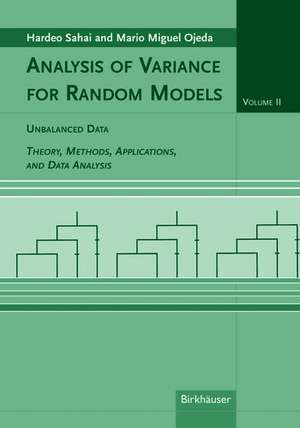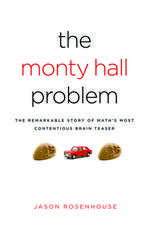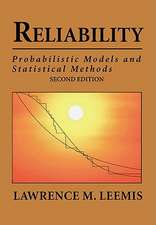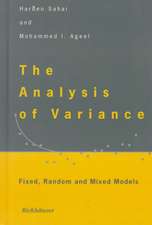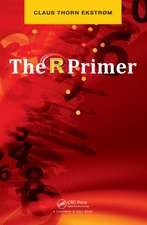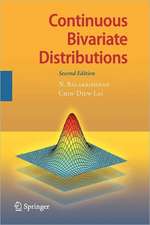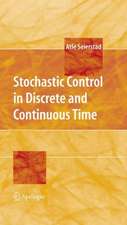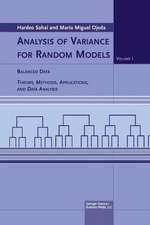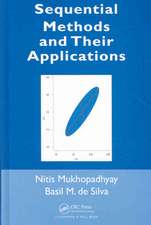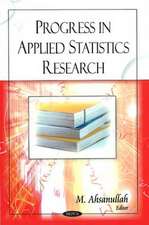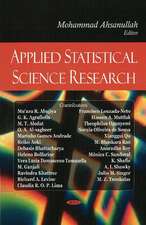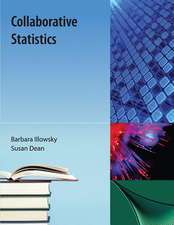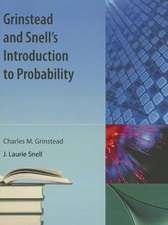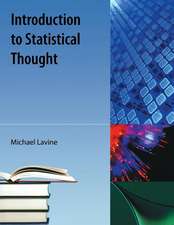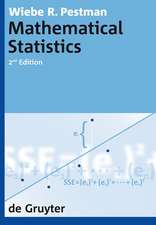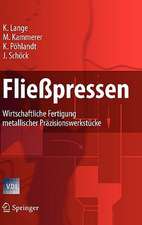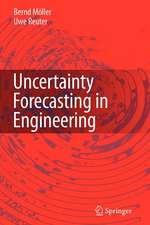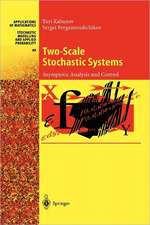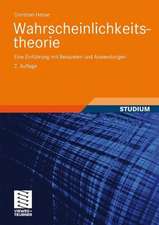Analysis of Variance for Random Models, Volume 2: Unbalanced Data: Theory, Methods, Applications, and Data Analysis
Autor Hardeo Sahai, Mario M. Ojedaen Limba Engleză Hardback – 12 noi 2004
This two-volume work is a comprehensive presentation of different methods and techniques for point estimation, interval estimation, and tests of hypotheses for linear models involving random effects. Both Bayesian and repeated sampling procedures are considered. Volume 1 examines models with balanced data (orthogonal models); Volume 2 studies models with unbalanced data (nonorthogonal models).
Accessible to readers with only a modest mathematical and statistical background, the work will appeal to a broad audience of students, researchers, and practitioners in the mathematical, life, social, and engineering sciences. It may be used as a textbook in upper-level undergraduate and graduate courses, or as a reference for readers interested in the use of random effects models for data analysis.
Preț: 406.63 lei
Nou
Puncte Express: 610
Preț estimativ în valută:
77.81€ • 81.82$ • 64.29£
77.81€ • 81.82$ • 64.29£
Carte tipărită la comandă
Livrare economică 17 aprilie-01 mai
Preluare comenzi: 021 569.72.76
Specificații
ISBN-13: 9780817632298
ISBN-10: 0817632298
Pagini: 480
Ilustrații: XXVI, 480 p.
Dimensiuni: 155 x 235 x 28 mm
Greutate: 0.85 kg
Ediția:2005
Editura: Birkhäuser Boston
Colecția Birkhäuser
Locul publicării:Boston, MA, United States
ISBN-10: 0817632298
Pagini: 480
Ilustrații: XXVI, 480 p.
Dimensiuni: 155 x 235 x 28 mm
Greutate: 0.85 kg
Ediția:2005
Editura: Birkhäuser Boston
Colecția Birkhäuser
Locul publicării:Boston, MA, United States
Public țintă
ResearchCuprins
Matrix Preliminaries and General Linear Model.- Some General Methods for Making Inferences about Variance Components.- One-Way Classification.- Two-Way Crossed Classification without Interaction.- Two-Way Crossed Classification with Interaction.- Three-Way and Higher-Order Crossed Classifications.- Two-Way Nested Classification.- Three-Way Nested Classification.- General r-Way Nested Classification.
Recenzii
From the reviews:
"This is the second of a two-volume comprehensive review of the analysis of variance for random effects models. Volume I was devoted to various models using balanced data, whereas this volume is concerned with unbalanced data. The book provides extensive coverage of the methods and techniques of point estimation, interval estimation and tests of hypotheses for random effects models. A variety of experimental designs are considered involving one, two, three and multi-factor experiments with crossed and nested factors. Throughout the text, the procedures are illustrated using numerical examples analyzed with several software systems.... The book will be particularly useful as a reference source to the literature of random effects models with each chapter having its own bibliography and with the main extensive reference section containing more than six hundred papers." —Short Book Reviews of the International Statistical Institute
"The book presents the theory, methods, data analysis, and applications requiring measurements of variance from several fields as agriculture, biology, applied genetics, animal breeding, medicine as well as eco-social sciences, including econometrics, quality control, and engineering. Numerical examples are given to analyse data and illustrate the theory and methods.… This monograph is an excellent book giving a survey of major theoretical and methodological developments for scientific research and application-oriented scientists." —Zentralblatt Math
Review of both volumes
"This two-volume set provides an encyclopedic and historical account of the theory and application of classical random-effects models.… For users of random-effects models and those interested in the theoretical development of this topic, these books are a valuable resource.… Throuhgout the [text], the authors go to great lengthsto provide references to original sources that would allow the reader to fill in details that are not included in the text.… By selecting an appropriate subset of topics, an instructor could create an outstanding graduate-level course on random-effects models.… These books provide an excellent unified reference on the methodological developments associated with classical random-effects models over the past 50 years." —Journal of the American Statistical Association
"This is the second volume of a two-volume monograph on analysis of variance for random and mixed linear models. … This book presents a systematic and comprehensive coverage of different methods and techniques, mainly of point estimations … . At the end of each chapter there is a wide variety of well-chosen exercises … . Each chapter ends with a complete bibliography for the references in that chapter. The book … is well written." (Jon Stene, Mathematical Reviews, Issue 2006 i)
"This is the second of a two-volume comprehensive review of the analysis of variance for random effects models. Volume I was devoted to various models using balanced data, whereas this volume is concerned with unbalanced data. The book provides extensive coverage of the methods and techniques of point estimation, interval estimation and tests of hypotheses for random effects models. A variety of experimental designs are considered involving one, two, three and multi-factor experiments with crossed and nested factors. Throughout the text, the procedures are illustrated using numerical examples analyzed with several software systems.... The book will be particularly useful as a reference source to the literature of random effects models with each chapter having its own bibliography and with the main extensive reference section containing more than six hundred papers." —Short Book Reviews of the International Statistical Institute
"The book presents the theory, methods, data analysis, and applications requiring measurements of variance from several fields as agriculture, biology, applied genetics, animal breeding, medicine as well as eco-social sciences, including econometrics, quality control, and engineering. Numerical examples are given to analyse data and illustrate the theory and methods.… This monograph is an excellent book giving a survey of major theoretical and methodological developments for scientific research and application-oriented scientists." —Zentralblatt Math
Review of both volumes
"This two-volume set provides an encyclopedic and historical account of the theory and application of classical random-effects models.… For users of random-effects models and those interested in the theoretical development of this topic, these books are a valuable resource.… Throuhgout the [text], the authors go to great lengthsto provide references to original sources that would allow the reader to fill in details that are not included in the text.… By selecting an appropriate subset of topics, an instructor could create an outstanding graduate-level course on random-effects models.… These books provide an excellent unified reference on the methodological developments associated with classical random-effects models over the past 50 years." —Journal of the American Statistical Association
"This is the second volume of a two-volume monograph on analysis of variance for random and mixed linear models. … This book presents a systematic and comprehensive coverage of different methods and techniques, mainly of point estimations … . At the end of each chapter there is a wide variety of well-chosen exercises … . Each chapter ends with a complete bibliography for the references in that chapter. The book … is well written." (Jon Stene, Mathematical Reviews, Issue 2006 i)
Textul de pe ultima copertă
Analysis of variance (ANOVA) models have become widely used tools and play a fundamental role in much of the application of statistics today. In particular, ANOVA models involving random effects have found widespread application to experimental design in a variety of fields requiring measurements of variance, including agriculture, biology, animal breeding, applied genetics, econometrics, quality control, medicine, engineering, and social sciences.
This two-volume work is a comprehensive presentation of different methods and techniques for point estimation, interval estimation, and tests of hypotheses for linear models involving random effects. Both Bayesian and repeated sampling procedures are considered. Volume I examines models with balanced data (orthogonal models); Volume II studies models with unbalanced data (nonorthogonal models).
Features and Topics:
* Systematic treatment of the commonly employed crossed and nested classification models used in analysis of variance designs
* Detailed and thorough discussion of certain random effects models not commonly found in texts at the introductory or intermediate level
* Numerical examples to analyze data from a wide variety of disciplines
* Many worked examples containing computer outputs from standard software packages such as SAS, SPSS, and BMDP for each numerical example
* Extensive exercise sets at the end of each chapter
* Numerous appendices with background reference concepts, terms, and results
* Balanced coverage of theory, methods, and practical applications
* Complete citations of important and related works at the end of each chapter, as well as an extensive general bibliography
Accessible to readers with only a modest mathematical and statistical background, the work will appeal to a broad audience of students, researchers, and practitioners in the mathematical, life, social, and engineering sciences. It may be used as a textbook in upper-level undergraduate and graduate courses, or as a reference for readers interested in the use of random effects models for data analysis.
This two-volume work is a comprehensive presentation of different methods and techniques for point estimation, interval estimation, and tests of hypotheses for linear models involving random effects. Both Bayesian and repeated sampling procedures are considered. Volume I examines models with balanced data (orthogonal models); Volume II studies models with unbalanced data (nonorthogonal models).
Features and Topics:
* Systematic treatment of the commonly employed crossed and nested classification models used in analysis of variance designs
* Detailed and thorough discussion of certain random effects models not commonly found in texts at the introductory or intermediate level
* Numerical examples to analyze data from a wide variety of disciplines
* Many worked examples containing computer outputs from standard software packages such as SAS, SPSS, and BMDP for each numerical example
* Extensive exercise sets at the end of each chapter
* Numerous appendices with background reference concepts, terms, and results
* Balanced coverage of theory, methods, and practical applications
* Complete citations of important and related works at the end of each chapter, as well as an extensive general bibliography
Accessible to readers with only a modest mathematical and statistical background, the work will appeal to a broad audience of students, researchers, and practitioners in the mathematical, life, social, and engineering sciences. It may be used as a textbook in upper-level undergraduate and graduate courses, or as a reference for readers interested in the use of random effects models for data analysis.
Caracteristici
Systematic treatment of the commonly employed crossed and nested classification models used in analysis of variance designs Detailed and thorough discussion of certain random effects models not commonly found in texts at the introductory or intermediate level Numerical examples to analyze data from a wide variety of disciplines Many worked examples containing computer outputs from standard software packages such as SAS, SPSS, and BMDP for each numerical example Extensive exercise sets at the end of each chapter Numerous appendices with background reference concepts, terms, and results Balanced coverage of theory, methods, and practical applications Complete citations of important and related works at the end of each chapter, as well as an extensive general bibliography Includes supplementary material: sn.pub/extras
